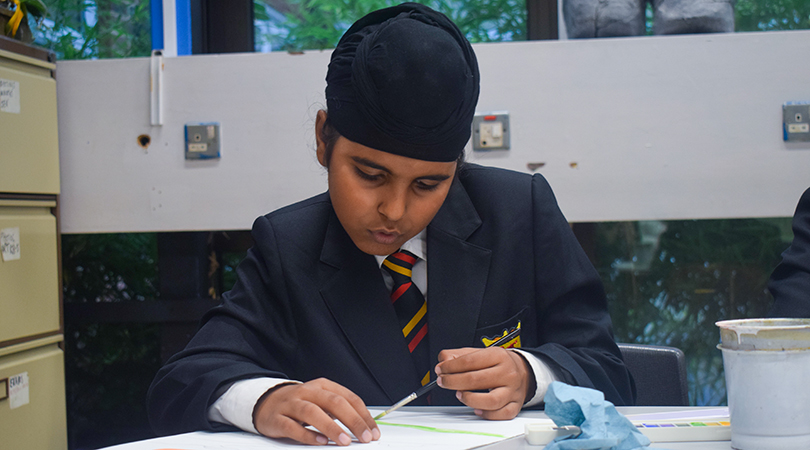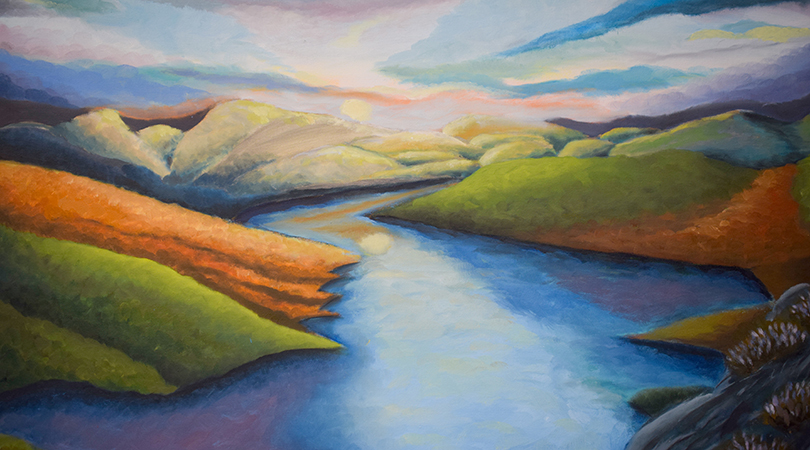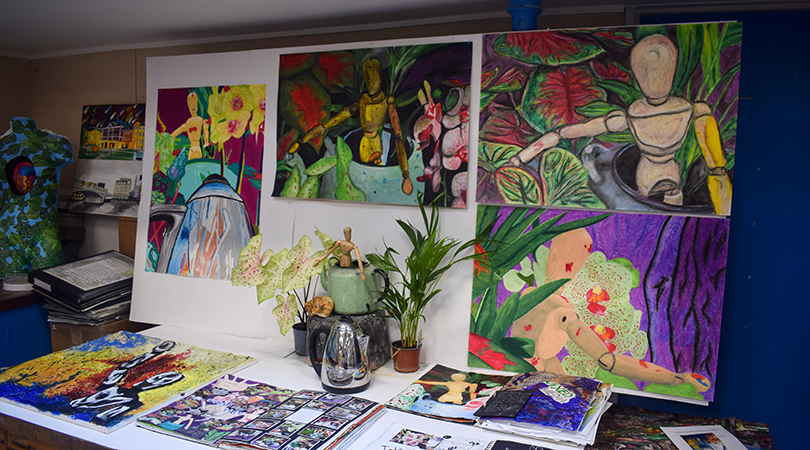We aim to build the skills of our students through a variety of activities which will enhance their learning at the same time as building their confidence. The skills they learn will also be of benefit in other subject areas.
Students will also explore the work and meanings of the work produced by various artists, craftspeople and designers from different cultures past and present in relation to their projects.
Understanding, appreciation and enjoyment of the visual arts have the power to enrich our personal and public lives.
Summary
Curriculum Content
Curriculum
Introduction to Drawing
This project aims to build up basic drawing skills through a variety of tasks looking at line, tone and contrast. Primary and secondary sources will be used as starting points. Pupils will also look at the work of various artists in relation to their tasks.
Media experimentation
Pupils will explore how to manipulate a range of media using colour theory to support their experiments.
Artist Research/Presentation
To enhance project work, pupils will research the work of artists using literacy skills. They will be shown how to lay out their work using graphic presentation.
Assessment
Introduction to Drawing
Continual assessment through verbal and written feedback with data input every half term.
Media experimentation
Continual assessment through verbal and written feedback with data input every half term.
Artist Research/Presentation
Continual assessment through verbal and written feedback with data input every half term.
Progress & Preparation Activities (PPA)
Tasks will be set based on classroom tasks, three per project.
Further Resources
The school has a subscription to The Day, an online news service for schools. Click the button to the right, then browse ‘Subjects’ in the top menu to find art resources.
Please see below for a number of resources to maximise students’ progress during their Year 7 curriculum.
- Amira Gale – to be used to support students with artist research.
- John Dilnot – to be used to collect images for the artist’s research PPA task.
- Kuriositas – to be used to help answer questions on Ernst Heackel for PPA task.
- Peter Clark – helpful for students to look at collage techniques used by Peter Clark to support mixed media work made in lesson.
- V&A – students will need to use the V&A website to search for the artist William Morris and answer questions about his art work.
Curriculum
Human Form
Pupils will be taught how to draw up the human form using measurements with artists’ manikins.
Portraits
Pupils will be taught how to calculate the proportions of the human face with the aim to produce a portrait They will also explore facial features eyes, noses, mouths and ears.
Art Mediums
This project gives pupils the opportunity to develop use different mediums using paint, oil pastels and mixed media.
Assessment
Human Form
Verbal and written feedback in books with data input every half term.
Portraits
Verbal and written feedback in books with data input every half term.
Mixed Mediums
Verbal and written feedback in books with data input every half term.
Progress & Preparation Activities (PPA)
Tasks will be set based on the project theme including contextual research, three per term.
Further Resources
The school has a subscription to The Day, an online news service for schools. Click the button to the right, then browse ‘Subjects’ in the top menu to find art resources.
Please see below for a number of resources to maximise students’ progress during their Year 8 curriculum.
- Van Gogh Gallery – to be used to help answer questions on Vincent Van Gogh for artists research PPA task.
- Guggenheim – students will need to use the Guggenheim website to search for the artist William Morris and answer questions about his art work.
- The Art Story – to be used to collect images of Alberto Giacometti’s portraits for artists research PPA task.
- National Portrait Gallery – to be used to research a portrait artist of their choice.
Curriculum
Pop Art
Pupils will explore the Pop Art movement from the late 1950s and 1960s, looking at culture, influences and artists. They will produce an A3 GCSE style book with supporting studies.
Day of the Dead
This project provides pupils the opportunity to explore the culture of Mexico through the production of written and practical work. Pupils will explore the Day of the Dead celebrations through the production of book work and supporting studies.
Skate Board
This project looks at the way that art plays a role in design. Pupils will design a skate board producing it as an A1 oil pastel study for display.
Assessment
Pop Art
Verbal and written feedback in books with data input every half term.
Day of the Dead
Verbal and written feedback in books with data input every half term
Skate Board
Verbal and written feedback in books with data input every half term
Progress & Preparation Activities (PPA)
Tasks will be set based on the project brief for each theme (3).
Further Resources
The school has a subscription to The Day, an online news service for schools. Click the button to the right, then browse ‘Subjects’ in the top menu to find art resources.
Please see below for a number of resources to maximise students’ progress during their Year 9 curriculum.
- Tate Gallery – to be used to search for information on the Pop art movement and collect relevant facts related to the writing task.
- YouTube: Day of the Dead – can be used to watch a video on the Pop Art movement, as an introduction to the Pop Art unit of work.
- Chinese Culture – to be used to research information on the importance of the dragon in Chinese culture and art.
- NPG – to be used to research and explore different types of portraits.
Summary
To be successful, students should not only demonstrate a range of practical ability and skills but also show appreciation of art & design from a diverse range, past and present, relating to their own ideas. This will be achieved through increasing research skills, recording, developing and expressing ideas in working journals (sketchbooks) and portfolio sheets leading to final pieces of work. Commitment with independent learning and time management are essential elements in this GCSE where 60% of marks are gained from coursework.
GCSE Art & Design
Level: GCSE
Examination Board: AQA
Curriculum
In Year 10, coursework will explore the themes ‘Natural’ and ‘Man Made’. In these two projects, students will be encouraged to develop practical recording skills through the use of different mediums and techniques as well as researching the work of various artists that have worked with the themes. Students will also be taught how to develop artist research work supporting the themes as well as annotating their own practical work. Students will look at:
- Natural – Shells, plants, fruit, vegetables, fish and animals
- Manmade – Toys, man-made objects, built environment
Both themes will be supported with contextual research looking at the way various artists from different times and cultures have responded to the two areas.
Assessment
Verbal and written feedback using a PLC based on the project themes syllabus criteria will be used to monitor progress against target levels. The AQA marking grid will be referred to as coursework progresses. Pupils will be tracked throughout the year from which current working levels will be given every half term. Mock examination time will be allocated to the second task after which it will be assessed using the AQA criteria.
Further Resources
The school has a subscription to The Day, an online news service for schools. Click the button to the right, then browse ‘Subjects’ in the top menu to find art resources.
Please see below for a number of resources to maximise students’ progress during their Year 10 curriculum.
In art GCSE, resources should be collected from a variety of areas. Pupils should use independent time to explore the themes at relevant places of interest to support their work including museums and galleries. All major museum and galleries offer educational sites as well as providing information on individual artists. Art books also provided an excellent source of information to support themes.
- Tate Modern – official website for the Tate Modern.
- National Gallery – official website for the National Gallery.
- Tate Britain – official website for the Tate Britain.
- Hayward Gallery – find out more about the Hayward Gallery.
- V&A – official website for the V&A museum.
Curriculum
There will be one further coursework unit based on a previous examination paper from which pupils select a theme (several available). This will become the Year 11 Mock Examination, providing clear guidance on how to approach the externally-set paper as well as an indication of potential. Pupils will produce a working journal/sketchbook over a set period of time which will be followed by a 10-hour mock examination to produce a final piece of work supporting working journals/sketchbooks.
It is very important at this point that students pay full attention to the advice given by their teacher as they will be expected to collect their own resources linking to their chosen theme independently and work with their strongest skills.
This will be followed by the externally-set task/examination which will be set in January the following year where they will select a theme from several available responding with the production of a sketchbook over 10 weeks followed by a 10-hour period in which time they will produce a supporting study (final piece of work).
Assessment
Verbal and written feedback using a PLC based on the project themes syllabus criteria will be used to monitor progress against target levels. The AQA marking grid will be referred to as coursework progresses. Pupils will be tracked throughout the year from which current working levels will be given every half term. Mock examination time will be allocated to the final task after which it will be assessed using the AQA criteria.
Further Resources
The school has a subscription to The Day, an online news service for schools. Click the button to the right, then browse ‘Subjects’ in the top menu to find art resources.
Please see below for a number of resources to maximise students’ progress during their study of this course during Year 11.
Examination papers will have suggested resources linking to themes. Resources should be collected from a variety of areas. Pupils should use their independent time to explore the themes at relevant places of interest to support their work including museums and galleries. All major museum and galleries offer educational sites as well as providing information on individual artists. Art books also provided an excellent source of information to support themes.
- BBC Bitesize: GCSE Art & Design – offers clear, sound advice on all aspects of the GCSE.
- Tate Modern – official website for the Tate Modern.
- Tate Britain – official website for the Tate Britain.
- V&A – official website for the V&A museum.
Summary
A-Level Art & Design
Level: A-Level
Examination Board: AQA
Curriculum
The project-based Unit 1 will be thematic in the first instance, with set tasks based on the themes ‘Natural’ and ‘Man-Made’. After this, students will be encouraged to reflect on the themes to produce a personal response to an area of interest. Students will be expected to reflect on their ideas as they develop and to support them with contextual research leading to a presentation of personal responses in books and portfolio sheets. This will be further supported with a final piece of work.
Assessment
Unit 1 – Natural/Man-made (50%)
Continual assessment will be given as themes develop through verbal feedback and tracking progress. Students will be given the opportunity to make improvements to the unit of work at several stages before the final internal moderation which will be followed by a visit from external moderators.
Further Resources
The school has a subscription to The Day, an online news service for schools. Click the button to the right, then browse ‘Subjects’ in the top menu to find art resources.
Please see below for a number of resources to maximise students’ progress during their Year 12 curriculum.
It must be stressed that, at KS5, students are expected to undertake independent research with regards to gathering resources in a personal and informed response to the themes – it is an integral part of the course. Although the internet is of importance. there is no one site that covers the set themes. Students are expected to visit places of interest to support their work including major galleries and museums all of which have useful web-sites. The AQA web-site will also have advice for students.
- Tate Modern – official website for the Tate Modern.
- National Gallery – official website for the National Gallery.
- Tate Britain – official website for the Tate Britain.
- Hayward Gallery – find out more about the Hayward Gallery.
- V&A – official website for the V&A museum.
- AQA – read the full specification and access mark schemes and past papers.
Curriculum
A-Level in Year 13 has two units of work – Unit 1 (Coursework) and Unit 2 (externally-set task/examination). Candidates are expected to consolidate the skills, knowledge and understanding developed during the AS course in both units of work. Students should also demonstrate the ability to work independently responding to chosen areas with visual and written skills.
Unit 1 – Personal Investigation: ‘Natural’ & ‘Man-Made’ – 60%
The coursework will be a project based on a theme. Students will explore their chosen area of interest through practical based work using a variety of mediums. Their work will be consolidated with a written element (1000-3000 words) supporting an aspect of the theme.
Unit 2 – Externally-Set Task – 40%
The externally-set task takes the form of an examination paper set by the examination board (AQA). Students will have the opportunity to respond to a theme of their choice, with several available. Students will respond to their chosen theme in the production of an informative working journal/sketchbook and portfolio sheets. A final response/piece of work will be completed over a 15-hour period.
Assessment
Unit 1 – Personal Investigation: ‘Natural’ & ‘Man-Made’
Continual assessment will be given through tracking and verbal feedback using a PLC based on AQA criteria. The project will be marked using the syllabus criteria and AQA matrix. Opportunities will be given to make improvements before final internal moderation. This will then be followed by external moderators.
Unit 2 – Externally-set task
Internal moderation will take place before a visit by external moderators.
Further Resources
The school has a subscription to The Day, an online news service for schools. Click the button to the right, then browse ‘Subjects’ in the top menu to find art resources.
Please see below for a number of resources to maximise students’ progress during their study of this course during Year 13.
Examples and areas to research will be provided on the examination paper. Thereafter, one-to-one sessions will take place where relevant areas for gathering resources can be discussed based on personal areas of interest.
- Tate Modern – official website for the Tate Modern.
- National Gallery – official website for the National Gallery.
- Tate Britain – official website for the Tate Britain.
- Hayward Gallery – find out more about the Hayward Gallery.
- V&A – official website for the V&A museum.
- AQA – read the full specification and access mark schemes and past papers.





